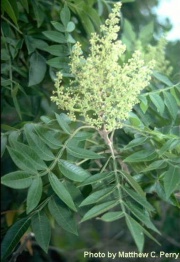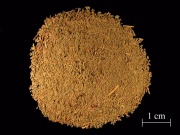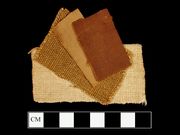Difference between revisions of "Sumac"
| (2 intermediate revisions by the same user not shown) | |||
| Line 3: | Line 3: | ||
[[File:sumac_powdered leaves.jpg|thumb|Powdered sumac leaves]] | [[File:sumac_powdered leaves.jpg|thumb|Powdered sumac leaves]] | ||
A tannin containing dye obtained from ''Rhus'' bushes, such as ''R. glabra'', ''R. cotinus'', ''R. coggygria'' (Venetian sumac or young fustic), ''R. typhina'' (American staghorn sumac), R. copallina (winged sumac), and ''R. coriaria'' (Sicilian sumac), that are native to the temperate and subtropical areas of Europe, Asia, and the Americas. Sumac has been used worldwide since ancient times. The berries, leaves, and bark are used for vegetable tanning of leathers and as red, black and yellow shades of dye. Sumac contains high levels of [[tannin|tannins]] (25 - 30%) and fisetin. The tannins are extracted from dried young twigs which are gathered before the plant has flowered. The leaves are beaten from the twigs and used separately as a dye. Berries, fermented or fresh, produce different shades of tan, red, and black depending on the variety of sumac. Iron mordants are used with sumac to produce black [[silk|silk]]. Sumac itself is used as a mordant for [[cotton|cotton]] and [[flax|flax]] fibers to afix other types of dyes, such as [[coal%20tar%20dye|coal tar dyes]]. | A tannin containing dye obtained from ''Rhus'' bushes, such as ''R. glabra'', ''R. cotinus'', ''R. coggygria'' (Venetian sumac or young fustic), ''R. typhina'' (American staghorn sumac), R. copallina (winged sumac), and ''R. coriaria'' (Sicilian sumac), that are native to the temperate and subtropical areas of Europe, Asia, and the Americas. Sumac has been used worldwide since ancient times. The berries, leaves, and bark are used for vegetable tanning of leathers and as red, black and yellow shades of dye. Sumac contains high levels of [[tannin|tannins]] (25 - 30%) and fisetin. The tannins are extracted from dried young twigs which are gathered before the plant has flowered. The leaves are beaten from the twigs and used separately as a dye. Berries, fermented or fresh, produce different shades of tan, red, and black depending on the variety of sumac. Iron mordants are used with sumac to produce black [[silk|silk]]. Sumac itself is used as a mordant for [[cotton|cotton]] and [[flax|flax]] fibers to afix other types of dyes, such as [[coal%20tar%20dye|coal tar dyes]]. | ||
| + | * See also [[https://cameo.mfa.org/wiki/Category:Uemura_dye_archive '''Uemera Dye Archive''' (Haze no ki)]] | ||
[[File:Sumac 4up 4.jpg|thumb|Sumac dyed fabric]] | [[File:Sumac 4up 4.jpg|thumb|Sumac dyed fabric]] | ||
== Synonyms and Related Terms == | == Synonyms and Related Terms == | ||
| Line 8: | Line 9: | ||
''Rhus cotinus; Rhus coggygria'' (Venetian sumac or young fustic); ''Rhus typhina'' (American staghorn sumac), ''Rhus copallina'' (winged sumac or shining sumac); ''Rhus coriaria'' (Sicilian sumac); ''Rhus glabra'' (smooth sumac); Gerberbaum (Deut.); sommacco (It.); zumaque de Sicilia (Esp.); smack (Ned.); sumak (Dan., Ned.); sumac (Fr.); Rhus (Deut., Fr.); shumack; shoemack; sumach; dyer's sumac; tanner's sumac | ''Rhus cotinus; Rhus coggygria'' (Venetian sumac or young fustic); ''Rhus typhina'' (American staghorn sumac), ''Rhus copallina'' (winged sumac or shining sumac); ''Rhus coriaria'' (Sicilian sumac); ''Rhus glabra'' (smooth sumac); Gerberbaum (Deut.); sommacco (It.); zumaque de Sicilia (Esp.); smack (Ned.); sumak (Dan., Ned.); sumac (Fr.); Rhus (Deut., Fr.); shumack; shoemack; sumach; dyer's sumac; tanner's sumac | ||
| − | == | + | == Resources and Citations == |
| − | J.Hofenk-de Graaf, ''Natural Dyestuffs: Origin, Chemical Constitution, Identification'', Central Research Laboratory for Objects of Art and Science, Amsterdam, September 1969. | + | * J.Hofenk-de Graaf, ''Natural Dyestuffs: Origin, Chemical Constitution, Identification'', Central Research Laboratory for Objects of Art and Science, Amsterdam, September 1969. |
| − | |||
| − | |||
* R.J. Adrosko, ''Natural Dyes in the United States'', Smithsonian Institution Press, Washington, DC, 1968 | * R.J. Adrosko, ''Natural Dyes in the United States'', Smithsonian Institution Press, Washington, DC, 1968 | ||
Latest revision as of 12:15, 22 June 2022
Description
A tannin containing dye obtained from Rhus bushes, such as R. glabra, R. cotinus, R. coggygria (Venetian sumac or young fustic), R. typhina (American staghorn sumac), R. copallina (winged sumac), and R. coriaria (Sicilian sumac), that are native to the temperate and subtropical areas of Europe, Asia, and the Americas. Sumac has been used worldwide since ancient times. The berries, leaves, and bark are used for vegetable tanning of leathers and as red, black and yellow shades of dye. Sumac contains high levels of tannins (25 - 30%) and fisetin. The tannins are extracted from dried young twigs which are gathered before the plant has flowered. The leaves are beaten from the twigs and used separately as a dye. Berries, fermented or fresh, produce different shades of tan, red, and black depending on the variety of sumac. Iron mordants are used with sumac to produce black Silk. Sumac itself is used as a mordant for Cotton and Flax fibers to afix other types of dyes, such as coal tar dyes.
- See also [Uemera Dye Archive (Haze no ki)]
Synonyms and Related Terms
Rhus cotinus; Rhus coggygria (Venetian sumac or young fustic); Rhus typhina (American staghorn sumac), Rhus copallina (winged sumac or shining sumac); Rhus coriaria (Sicilian sumac); Rhus glabra (smooth sumac); Gerberbaum (Deut.); sommacco (It.); zumaque de Sicilia (Esp.); smack (Ned.); sumak (Dan., Ned.); sumac (Fr.); Rhus (Deut., Fr.); shumack; shoemack; sumach; dyer's sumac; tanner's sumac
Resources and Citations
- J.Hofenk-de Graaf, Natural Dyestuffs: Origin, Chemical Constitution, Identification, Central Research Laboratory for Objects of Art and Science, Amsterdam, September 1969.
- R.J. Adrosko, Natural Dyes in the United States, Smithsonian Institution Press, Washington, DC, 1968
- G.S.Brady, Materials Handbook, McGraw-Hill Book Co., New York, 1971 Comment: p. 786
- Hermann Kuhn, Conservation and Restoration of Works of Art and Antiquities, Butterworths, London, 1986
- Matt Roberts, Don Etherington, Bookbinding and the Conservation of Books: a Dictionary of Descriptive Terminology, U.S. Government Printing Office, Washington DC, 1982
- Encyclopedia Britannica, http://www.britannica.com Comment: "sumac" [Accessed October 9, 2001].
- F. Crace-Calvert, Dyeing and Calico Printing, Palmer & Howe, London, 1876
- J. Thornton, 'The Use of Dyes and Colored Varnishes in Wood Polychromy', Painted Wood: History and Conservation, The Getty Conservation Insitute, Los Angeles, 1998


